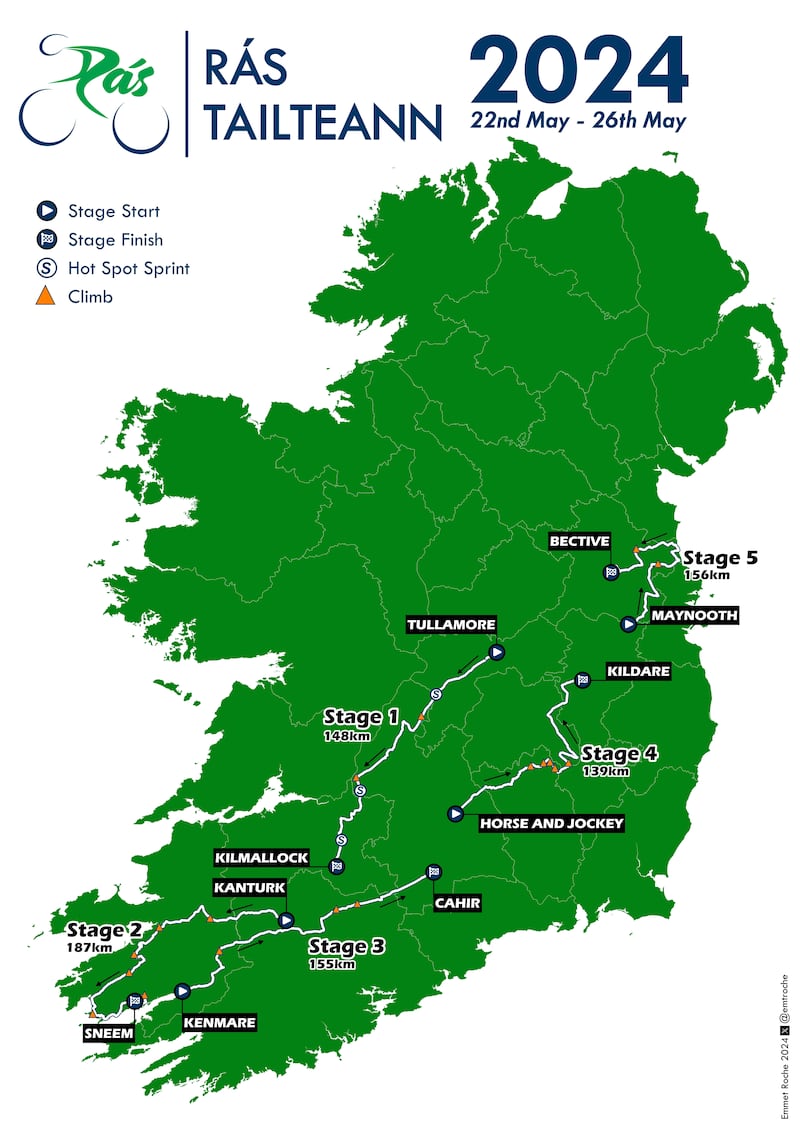Competitors in this year’s Rás Tailteann will face increased climbing over the previous two editions, with a total of 18 ascents to rise up along a challenging 784.9km route.
Beginning in Tullamore, Co Offaly on Wednesday, May 22nd, and concluding five days later in Bective in Co Meath on Sunday, May 26th, the race will see an international field squaring up against an Irish contingent which will be hoping to take a third consecutive home victory.
Day one incorporates two category three climbs plus twisting, undulating roads en route to a first-ever Rás stage finish in Kilmallock, Co Limerick.
The 2023 champion Dillon Corkery will be feted at the start of a much tougher stage two, with that leg beginning in his home town of Kanturk. The 187km race to Sneem will be both the longest and hilliest stage, with no less than six categorised climbs looming on the horizon.
RM Block
These include early category three hills at Scartaglen, Milltown, and Glencar, with the gruelling category one climb of Ballaghasheen pass and the difficult category two ascent of Coomakista coming prior to a 16km finishing circuit in Sneem. A final category three climb on that loop could well be a springboard to stage victory and the yellow jersey.
Stage three from Kenmare is more straightforward, with three categorised climbs balanced by a mostly flat and fast roads en route to the first finish in Cahir since 1967.

Day four includes the second category one climb of the race, that of Gorteen. That comes after two earlier, easier category three climbs, and while a pair of second cat ascents lie between Castlecomer and Carlow, a flatter 60km run in to the finish in Kildare town may well see a partial or full regrouping.
Ireland’s biggest men’s stage race will then end with a race from Maynooth to Bective, incorporating three laps of a 14.1km finishing circuit.
While two category three climbs should not pose too much of a challenge, a similarly straightforward-looking stage last year saw Corkery upend the classification by getting into a dangerous breakaway move.
“We are delighted to be able to reveal details of the Rás Tailteann 2024 route,” said race director Gerard Campbell. “This year’s route is more difficult than the previous two editions, with a welcome return to cycling strongholds such as ‘The Rebel’ and ‘The Kingdom’ counties.
“There are a series of very tricky climbs along the way southwards and back up the country towards our ultimate finish in Bective on Sunday, May 26th, for what promises to be an extra special day.”
Campbell said that details about race entries would be released soon. “There is already huge interest from teams here at home and abroad. We will also be releasing details of our sponsors and funding partners in due course.”
The Irish Times understands that the race is in a more secure position than the past two years in terms of financial backing.
Rás Tailteann 2024
Stage 1, Wednesday, May 22nd: Tullamore to Kilmallock (148km)
Stage 2, Thursday May 23rd: Kanturk to Sneem (187km)
Stage 3, Friday May 24th: Kenmare to Cahir (155km)
Stage 4, Saturday May 25th: Horse and Jockey to Kildare Town (139km)
Stage 5, Sunday May 26th: Maynooth to Bective (156km)




















